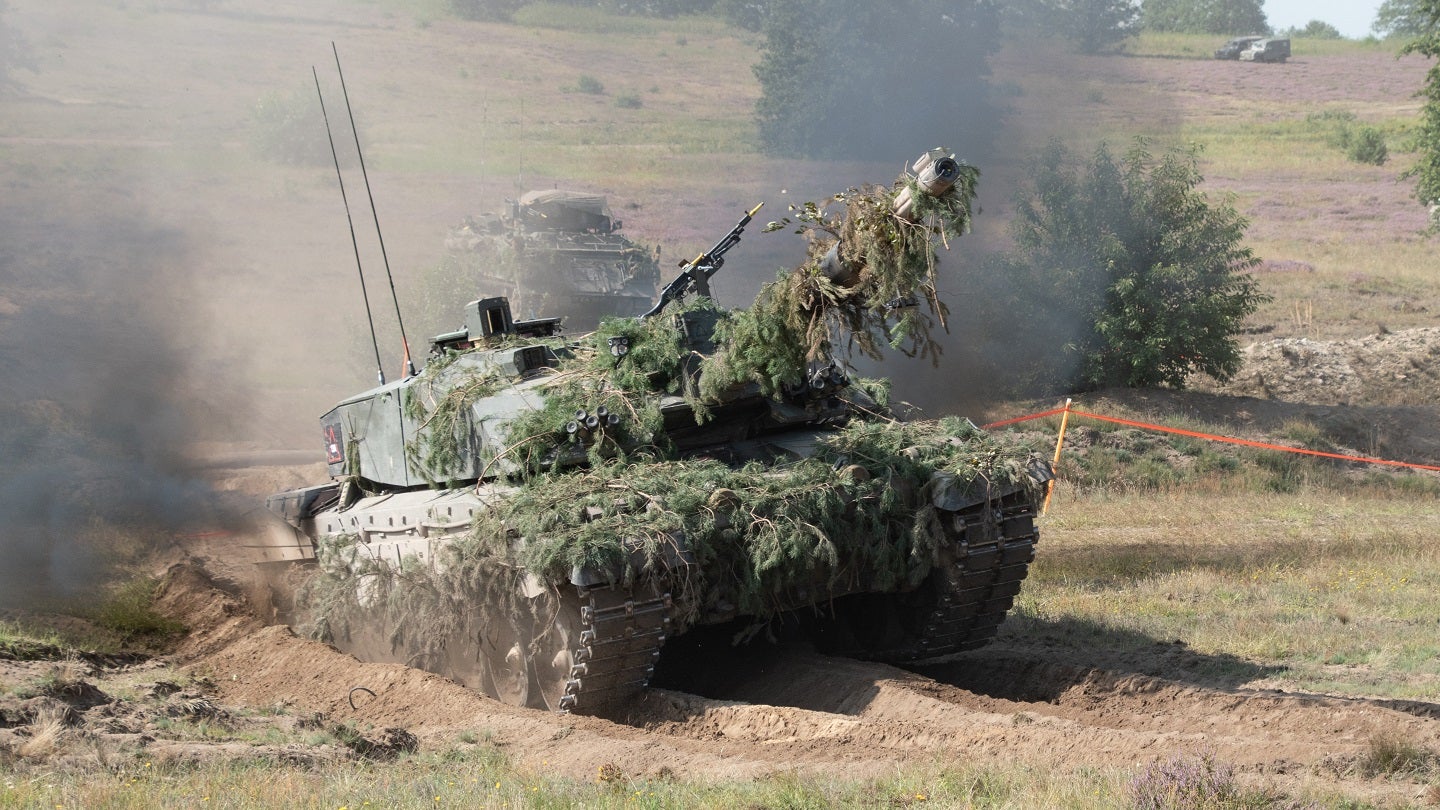
A quarter of a century after first entering military service, a Challenger 2 main battle tank (MBT) looks to have been destroyed in combat, following the release of imagery on social media purporting to show one of the UK-designed MBTs burning in Ukraine.
The short video, released on 4-5 September, shows the burning wreck of a Challenger 2 that was being operated by the Ukrainian military during combat operations against Russia, potentially near Robotyne. The crew survived the incident, an indication to the levels of protection provided by western tank designs, compared to platforms operated and proliferated by Russia.
In April this year the UK completed the delivery of 14 Challenger 2 MBTs to Ukrainian forces, where it is thought they have been operated by Ukraine’s 82nd Air Assault Brigade. The announcement on 21 April stated that the UK has delivered the 14 Challenger 2 tanks, along with 32 AS90 155mm self-propelled guns, and more than 150 CVR(T) and Bulldog armoured personnel carriers.
Ukrainian crews were also provided extensive training on the platform in the UK before returning to Ukraine as it geared up for the counteroffensive, which currently is showing indications of a breakthrough around Verbove after weeks of grinding attrition.
The UK has granted significant quantities of additional military equipment to Ukraine, including M270 MLRS systems, dozens of 105mm L119 light guns, and hundreds of other light vehicles and trucks. In addition, tens of thousands of artillery shells and million of rounds of small arms ammunition, along with anti-tank systems such as the NLAW, have also been provided.
On 4 September Ukrainian President Volodymyr Zelenskyy visited personnel operating in the Zaporizhzhia region, including the command posts of the 148th Separate Artillery Brigade, 82nd Separate Air Assault Brigade, and 71st Separate Hunting Brigade, according to the Ukrainian Ministry of Defence (MoD)
Updating its daily combat operations report, the Ukrainian MoD stated on 5 September that since the start of the Russian invasion on 24 February 2022, its forces had destroyed 4489 (+9 in the preceding 24-hour period) Russian tanks, 8670 (+7) armoured personnel carriers, 5649 (+38) artillery systems, 747 (+6) MLRS systems, 504 (+1) anti-aircraft systems, 331 (+0) fixed- and rotary-wing aircraft, and 4512 (+31) tactical-level uncrewed aerial vehicles.
The figures are unable to be independently verified but are likely in excess of actual equipment losses. Nevertheless, the material loss of Russia’s military has been significant, with GlobalData analysis indicating that up to December 2022, the combined Ukraine-Russia equipment loss was ten times that sustained during Moscow’s cumulative loss during both Chechen Wars in the 1990s and early 2000s, with over 11,000 systems destroyed.
In February this year analysis indicated that the combined Ukraine and Russia casualty count, including both killed in action and those wounded, was up to 300,000. Broken down, it was thought that Russia sustained around 175-200,000 casualties, while Ukraine was considered to have suffered 100,000 casualties, during the first year of combat operations.
UK Challenger 3 upgraded to include additional ‘active’ protection
The apparent first combat loss of a Challenger 2 marks a significant, if unwanted, milestone for the type, which has operated across Europe and Iraq with the British military and is also in service with the Armed Forces of the Sultanate of Oman.
Equipped with advanced Chobham armour, thought to be a composite material designed to withstand anti-armour munitions, the Challenger 2 had gained a reputation as a leading MBT of the early 2000s.
However, the type does not have an active protection system (APS) fitted, as with many other MBTs, which sees reactive armour panels integrated onto the vehicle’s structure that sense when an incoming anti-armour round is about to impact, before detonating an explosive charge to neutralise the threat.
The UK is upgrading 148 of its remaining Challenger 2 MBTs to the new Challenger 3 variant, which will see the integration of a new L55A1 main gun as well the Trophy APS.
In March this year Army Technology reported that the British Army had just 157 Challenger 2 MBTs either on or available to undertake operations within a 30-day work-up period, out of a theoretical fleet of 227 vehicles.
Suggestions that the number of UK Challenger 2s upgraded to the Challenger 3 variant could increase in the refresh of the 2021 Integrated Review came to nothing, with the number remained at 148 vehicles.





